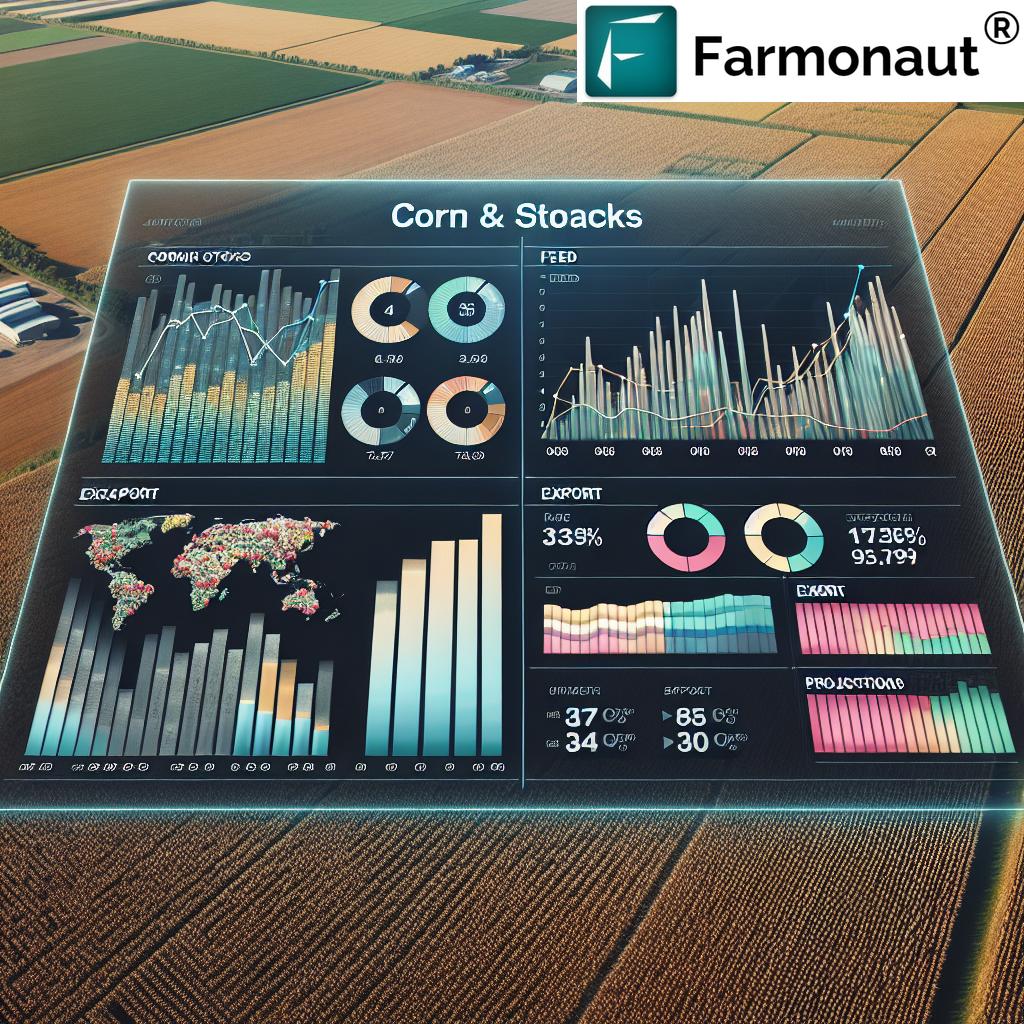USDA June Corn Stocks Forecast: Impact on Feed, Ethanol, and Market Projections
“USDA anticipates June 1 corn stocks of 4.897 billion bushels, 306 million lower than 2019.”
As we approach the release of the United States Department of Agriculture’s (USDA) June corn stocks estimate, the agricultural community is buzzing with anticipation. This critical report holds significant implications for crop yield forecasting, farm management strategies, and overall market dynamics. In this comprehensive analysis, we’ll delve into the expected impact on feed, ethanol production, and market projections, providing valuable insights for farmers, agribusinesses, and precision agriculture technology adopters.
Understanding the USDA Corn Stocks Estimate
The USDA corn stocks estimate is a pivotal report that offers a snapshot of the current state of corn supply and demand in the United States. It provides crucial data on corn inventories, which helps stakeholders across the agricultural sector make informed decisions about production, marketing, and policy.
- Timing: Released quarterly, with the June report being particularly significant
- Data sources: On-farm surveys and off-farm facility reports
- Key metrics: Total corn stocks, on-farm storage, and off-farm storage
For those utilizing Farmonaut’s advanced farm management tools, understanding these estimates is crucial for optimizing crop management and maximizing profitability. Our satellite-based crop monitoring system can help you align your strategies with market projections.
Projected June 1 Corn Stocks
Based on expert analyses and market trends, the anticipated June 1 corn stocks are estimated to be around 4.897 billion bushels. This projection is 306 million bushels lower than the previous year, reflecting changes in consumption patterns and production levels.
Let’s break down the key factors influencing this estimate:
- Domestic Usage: Changes in feed demand and industrial use
- Exports: Fluctuations in international demand and trade policies
- Production: Weather conditions and planting progress
- Carryover: Previous year’s ending stocks
To help visualize these changes, we’ve prepared a comparative data table:
| Category | June 1, 2020 Estimate (billion bushels) | June 1, 2019 Actual (billion bushels) | Year-over-Year Change (%) |
|---|---|---|---|
| Total Stocks | 4.897 | 5.203 | -5.9% |
| Exports | 1.775 | 2.065 | -14.0% |
| Domestic Usage | 11.325 | 11.795 | -4.0% |
| Feed and Residual | 5.700 | 5.897 | -3.3% |
This data aligns with USDA consumption projections and suggests relatively neutral market implications for corn prices. However, it’s crucial to note that actual consumption rates during the marketing year could shift this outlook.
Impact on Feed and Residual Levels
The corn feed and residual levels are a critical component of domestic usage. For the 2019/2020 marketing year, the USDA projects feed and residual use at 5.700 billion bushels, down from 5.897 billion the previous year.
Several factors contribute to this decrease:
- Changing livestock inventories
- Fluctuations in grain prices
- Availability of alternative feed sources
- Weather conditions affecting feed efficiency
For farmers using Farmonaut’s precision agriculture technology, these projections can inform decisions about crop allocation and livestock management strategies.
Ethanol Production Impact on Corn Consumption
“COVID-19’s impact on ethanol production significantly influenced corn consumption trends and market projections.”
The ethanol industry plays a significant role in corn consumption, typically accounting for about 35% of total corn use. However, the COVID-19 pandemic has dramatically altered this landscape.
Key points to consider:
- Reduced fuel demand due to travel restrictions
- Temporary closures of ethanol plants
- Shifting government policies on renewable fuel standards
These factors have led to a substantial decrease in corn used for ethanol production, impacting overall corn consumption trends and market projections. Farmonaut’s AI-powered advisory system, Jeevn AI, can help farmers navigate these market shifts by providing personalized crop management strategies.
Agricultural Market Projections
Based on the USDA corn stocks estimate and current market conditions, we can make several projections for the agricultural market:
- Corn Prices: Likely to remain stable in the short term, with potential for slight increases if stocks come in lower than expected
- Planting Decisions: Farmers may adjust their planting intentions for the upcoming season based on these projections
- International Trade: Export demand could fluctuate based on global economic recovery and trade policies
- Livestock Sector: Feed costs may impact profitability and production decisions
For a more detailed analysis of these projections and their potential impact on your farming operations, consider using Farmonaut’s advanced agricultural risk assessment tools.
Implications for Crop Yield Forecasting
The June corn stocks report provides valuable data for refining crop yield forecasts. By comparing current stocks with historical data and considering factors such as weather patterns and planting progress, we can develop more accurate yield projections.
Key considerations for crop yield forecasting:
- Acreage planted and emergence rates
- Soil moisture levels and irrigation needs
- Pest and disease pressure
- Technological advancements in farming practices
Farmonaut’s satellite-based crop health monitoring system can provide real-time data on these factors, helping you make informed decisions about your crop management strategies.
Farm Management Tools and Strategies
In light of these market projections and the evolving agricultural landscape, implementing effective farm management tools and strategies is more crucial than ever. Farmonaut offers a range of solutions to help you optimize your farming operations:
- Satellite-Based Crop Monitoring: Real-time insights into crop health and soil moisture levels
- AI-Powered Advisory: Personalized recommendations for crop management and resource allocation
- Blockchain-Based Traceability: Ensure transparency and build trust in your supply chain
- Fleet and Resource Management: Optimize your agricultural machinery usage and reduce operational costs
By leveraging these advanced tools, you can make data-driven decisions that enhance your farm’s productivity and profitability.
Grain Market Analysis and Risk Assessment
A thorough grain market analysis is essential for developing effective risk management strategies. Consider the following factors when assessing market risks:
- Supply and demand dynamics
- Price volatility and trends
- Storage capacity and costs
- Transportation and logistics
- Government policies and trade agreements
Farmonaut’s platform integrates real-time market data with your farm-specific information, providing a comprehensive view of potential risks and opportunities. Our blockchain-based traceability solutions can also help you capitalize on premium markets that value transparency and sustainability.
Precision Agriculture Technology: A Game-Changer
The adoption of precision agriculture technology is revolutionizing the way farmers approach crop management and decision-making. Farmonaut’s suite of tools exemplifies this technological advancement:
- Satellite Imagery Analysis: Monitor crop health and identify potential issues before they become visible to the naked eye
- Weather Forecasting: Access hyper-local weather predictions to optimize planting, irrigation, and harvesting schedules
- Yield Mapping: Create detailed maps of your fields to identify high and low-performing areas
- Variable Rate Application: Optimize input use by applying fertilizers and pesticides only where needed
By integrating these technologies into your farming practices, you can significantly improve resource efficiency and crop yields while reducing environmental impact.
Looking Ahead: Future Trends and Considerations
As we analyze the USDA June corn stocks forecast and its implications, it’s important to consider future trends that may shape the agricultural landscape:
- Climate Change: Adapting to changing weather patterns and extreme events
- Sustainable Agriculture: Increasing focus on environmentally friendly farming practices
- Technological Advancements: Continued integration of AI, IoT, and robotics in farming
- Consumer Preferences: Shifting demands for organic, non-GMO, and locally sourced products
- Global Trade Dynamics: Evolving international relationships and trade policies
Staying informed about these trends and leveraging tools like Farmonaut’s AI advisory system can help you position your farm for long-term success.
Conclusion: Empowering Decision-Making with Data
The USDA June corn stocks forecast provides valuable insights into the current state of the corn market and its potential future directions. By understanding these projections and their implications for feed, ethanol production, and overall market dynamics, farmers and agribusinesses can make more informed decisions about their operations.
Farmonaut’s suite of precision agriculture tools offers a powerful way to leverage this data, combining market insights with farm-specific information to optimize crop management and maximize profitability. From satellite-based crop monitoring to AI-powered advisories, our platform empowers you to make data-driven decisions that can significantly impact your farm’s success.
As we navigate the complex and ever-changing agricultural landscape, staying informed and adopting innovative technologies will be key to thriving in the years to come. With Farmonaut as your partner, you’ll have the tools and insights needed to face these challenges head-on and seize new opportunities as they arise.
FAQ Section
Q: How often is the USDA corn stocks report released?
A: The USDA releases corn stocks reports quarterly, with the June report being particularly significant for market projections.
Q: How does ethanol production impact corn consumption?
A: Ethanol production typically accounts for about 35% of total corn use, making it a significant factor in corn consumption trends. However, recent events like the COVID-19 pandemic have led to fluctuations in this relationship.
Q: What factors influence corn feed and residual levels?
A: Key factors include livestock inventories, grain prices, availability of alternative feed sources, and weather conditions affecting feed efficiency.
Q: How can Farmonaut’s tools help in interpreting market projections?
A: Farmonaut’s AI-powered advisory system and satellite-based crop monitoring tools can help farmers align their strategies with market projections by providing personalized crop management recommendations and real-time field data.
Q: What are some key considerations for crop yield forecasting?
A: Important factors include acreage planted, emergence rates, soil moisture levels, pest and disease pressure, and technological advancements in farming practices.
For more information on how Farmonaut can help you optimize your farming operations and make the most of market projections, visit our web app, download our Android app or iOS app, or explore our API for custom integrations. You can also check out our API Developer Docs for detailed information on how to leverage our satellite and weather data in your own systems.








